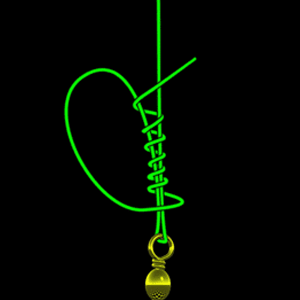 Here’s a little tidbit that you might find interesting. If you’ve ever studied knots and how they’re formed, as well as how they break under pressure, you’ll find that one of the causes of knot failure is due to a weakening that starts with rotation of the line within the knot. Makes sense if you think about it.
Here’s a little tidbit that you might find interesting. If you’ve ever studied knots and how they’re formed, as well as how they break under pressure, you’ll find that one of the causes of knot failure is due to a weakening that starts with rotation of the line within the knot. Makes sense if you think about it.
Here’s where it gets cool. The researchers that found the torsion in the fluorocarbon knots then tested the theory on unknotted line. If you pull on twisted unknotted line until failure, theoretically you should end up with a break that appears to have been at least partly caused by the twisting. This was, in fact, exactly what they found. So what?
The cool part wasn’t that the line broke in the same fan-type pattern, but that the more twisted the fluorocarbon line segment tested, the easier it was to break – twisted fluorocarbon line was simply not as strong as untwisted fluoro line. The more twists per length of line, the less the overall breaking strength. Researchers started with 3 twists per foot, and that fluorocarbon broke at about 80% of full strength. By the time they got to 9 twists (full revolutions) per foot, the fluorocarbon had weakened to about 55%. After that, the response curve flattened, meaning further twisting didn’t weaken the line any worse.
In reality, I don’t know if this would ever translate out on the water, but it makes for a good excuse as to why you might not want to fish with overly twisted line, not to mention the fact that it makes for a great knowledge drop the next time you and your buddy are discussing bass fishin’ over a beer or two.

























Jeff Hahn
October 8, 2012 at 7:25 am
Put fluoro on a spinning reel by winding it off the side of the storage spool makes it lay flat on the reel spool. But, once a cast is made, the line comes off twisted.
But, if you put fluoro or any stiff mono line on a spinning reel by off coming off the top of the manufacturer’s storage spool, like you would with a casting reel, the line is on the spinning reel spool is twisted and tends to misbehave by spring off the spool at the most inopportune moments.
So, which method should be used to fill a spinning reel, given this research? Hmmm…
admin (mostly Jay)
October 8, 2012 at 1:02 pm
Sounds like no fluoro on spinning gear….
Randy S Breth
October 8, 2012 at 8:39 pm
Yeah – I tried straight fluoro on spinning gear years ago – never liked it. Now it’s superlines and only use fluoro for leaders on spinning gear. I haven’t noticed twist effecting the leaders strength though. Interesting.
A J Faria
October 18, 2012 at 8:06 pm
What would you suggest for clear water?
Curt Compton
April 23, 2013 at 2:29 pm
I always use a Palomar Knot whether it is fluoro or not. If twists are bad for Fluorocarbon then Palomar would be the best knot.